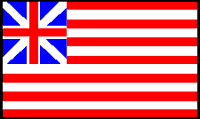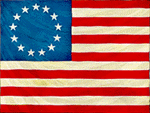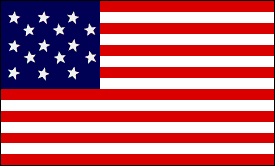
* June 14, 1777, in order to establish an official flag for
the new nation, the Continental Congress passed the first Flag Act.
"Resolved, That the flag of the United States be made of thirteen
stripes, alternate red and white; that the union be thirteen
stars, white in a blue field, representing a new Constellation."
* Act of January 13, 1794 - provided for 15 stripes and 15
stars after May 1795.
* Act of April 4, 1818 - provided for 13 stripes and one
star for each state, to be added to the flag on the 4th of July
following the admission of each new state.
* June 24, 1912 - established proportions of the flag and
provided for arrangement of the stars in six horizontal rows of
eight each, a single point of each star to be upward.
* January 3, 1959 - provided for the arrangement of the
stars in seven rows of seven stars each, staggered horizontally
and vertically.
* August 21, 1959 - provided for the arrangement of the
stars in nine rows of stars staggered horizon tally and eleven
rows of stars staggered vertically.
The Betsy Ross Flag
Each star and stripe represented each of the 13 colonies.
The 13 colonies are listed below with the date that each
became a State.
Delaware December 7th, 1787
Pennsylvania December 12th,1787
New Jersey December18th, 1787
Georgia January 2nd, 1788
Connecticut January 9th, 1788
Massachusetts February 6th, 1788
Maryland April 28th, 1788
South Carolina May 23rd, 1788
New Hampshire June 21st, 1788
Virginia June 25th, 1788
New York July 25th, 1788
North Carolina November 21st, 1789
Rhode Island May 29th, 1790
Flag Day
Flag Day - the anniversary of the Flag Act of 1777 - was
officially established by the Proclamation of President
Woodrow Wilson on May 30th, 1916.
On August 3rd, 1949, President Harry Truman signed an Act of Congress
designating June 14th of each year as National Flag Day.
Grand Union Flag

1776 January 1 -- The Grand Union flag.
1776 May -- Betsy Ross sews the first American flag.
1777 June 14 -- Continental Congress adopts the following: Resolved:
that the flag of the United States be thirteen stripes, alternate
red and white; that the union be thirteen stars,
white in a blue field, representing a new constellation.
Betsy Ross Flag

1795 Flag with 15 stars and 15 stripes (Vermont, Kentucky)
1818 Flag with 20 stars and 13 stripes (it remains at 13 hereafter)
(Tennessee, Ohio, Louisiana, Indiana, Mississippi)
1819 Flag with 21 stars (Illinois)
1820 Flag with 23 stars (Alabama, Maine)
1822 Flag with 24 stars (Missouri)
1836 Flag with 25 stars (Arkansas)
1837 Flag with 26 stars (Michigan)
1845 Flag with 27 stars (Florida)
1846 Flag with 28 stars (Texas)
1847 Flag with 29 stars (Iowa)
1848 Flag with 30 stars (Wisconsin)
1851 Flag with 31 stars (California)
1858 Flag with 32 stars (Minnesota)
1859 Flag with 33 stars (Oregon)
1861 Flag with 34 stars; (Kansas)
1863 Flag with 35 stars (West Virginia)
1865 Flag with 36 stars (Nevada)
1867 Flag with 37 stars (Nebraska)
1877 Flag with 38 stars (Colorado)
1890 Flag with 43 stars (North Dakota, South Dakota, Montana,
Washington, Idaho)
1891 Flag with 44 stars (Wyoming)
1896 Flag with 45 stars (Utah)
1908 Flag with 46 stars (Oklahoma)
1912 Flag with 48 stars (New Mexico, Arizona)
1959 Flag with 49 stars (Alaska)
1960 Flag with 50 stars (Hawaii)
Flag Flown Over Fort McHenry

Time and Occasions For Flag Display
(a) It is the universal custom to display the flag only from
sunrise to sunset on buildings and on stationary flagstaffs in the
open. However, when a patriotic effect is desired, the flag
may be displayed twenty-four hours a day if properly
illuminated during the hours of darkness.
(b) The flag should be hoisted briskly and lowered ceremoniously.
(c) The flag should not be displayed on days when the weather
is inclement, except when an all weather flag is displayed.
(d) The flag should be displayed on all days, especially on
New Year's Day, January 1
Inauguration Day, January 20
Lincoln's Birthday, February 12
Washington's Birthday, third Monday in February
Easter Sunday (variable),
Mother's Day, second Sunday in May
Armed Forces Day, third Saturday in May
Memorial Day (half-staff until noon), the last Monday in May
Flag Day, June 14
Independence Day, July 4
Labor Day, first Monday in September
Constitution Day, September 17
Columbus Day, second Monday in October
Navy Day, October 27
Veterans Day, November 11
Thanksgiving Day, fourth Thursday in November
Christmas Day, December 25
and such other days as may be proclaimed by the President
of the United States; the birthdays of States (date of admission);
and on State holidays.
(e) The flag should be displayed daily on or near the main
administration building of every public institution.
(f) The flag should be displayed in or near every polling place
on election days.
(g) The flag should be displayed during school days in or
near every schoolhouse.
Back to All about Flag Day
Back To Famous Places & People
Tippy & Alfred's Fun Pet Newsletter
Search Our Site
Pet Care Tips Directory
Gift Items for All Pet Lovers
Enchanting Stuffed Plush Animals
Canine Care Tips
Feline Care Tips
Horse Care Tips
Site Map
Copyright ©
Choose To Prosper